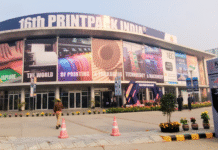Toppan Printing (Toppan), a global leader in communication, security, packaging, décor materials, and electronics solutions, has developed a more eco-friendly manufacturing method for offset printing that combines oil-based biomass ink with water-based varnish. Ecoluster is an addition to Toppan’s “sustainable value packaging” lineup, which is part of the recently launched “Toppan S-value packaging” range targeting added value for society and fulfilling living.
Oil-based inks used in offset printing are known for their broad-spectrum and excellent reproduction of colors. However, oil-based printing has, until now, entailed long lead times and lower productivity, meaning that fast-drying UV offset printing is widely adopted as it can significantly reduce timeframes for manufacturing.
Toppan ecoluster has been developed to address this by leveraging new materials and manufacturing methodology and combining oil-based biomass ink with water-based varnish.
Toppan ecoluster enables productivity significantly greater than conventional oil-based printing and manufacturing lead times equivalent to those of UV printing used extensively for folding cartons. The use of plant-derived material and the absence of UV lamps make it possible to reduce carbon dioxide emissions associated with raw ink materials and the printing process by roughly 34% compared with general UV offset printing.
In addition, because ink other than metallic ink uses oil-based biomass material that can display marks for biomass and plant-derived inks on products. Toppan Ecoluster also achieves reproduction quality and properties equivalent to UV sheet-fed printing by offering the outstanding colors of oil-based inks, smooth ink surfaces, friction resistance, and the same gloss look without using UV curing materials.
Takeda commenting on Toppan ecoluster benefits
“Ecoluster meets needs for enhanced production efficiency and reduced environmental impact while supplying outstanding color and print quality,” said Akira Takeda, general manager of manufacturing technology in Toppan’s Living & Industry Division.
“Toppan will continue to drive enhanced functionality for packaging products, applying more eco-friendly offset printing to packaging for food and fast-moving consumer goods and adding value to contribute to a sustainable society.”
Ecoluster will be on display in the Toppan Booth (S1-12, South Hall 1) at Tokyo Pack, 2021, held at the Tokyo Big Sight exhibition center from 24 to 26 February.
















